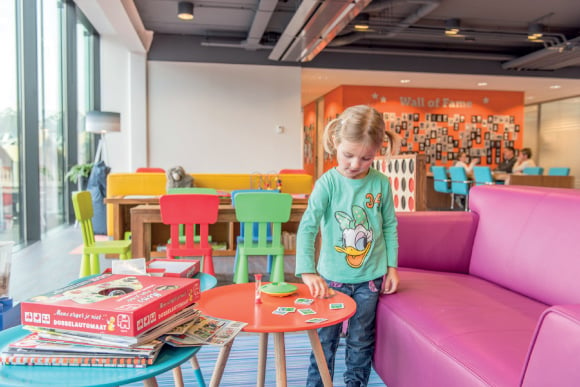HealthManagement, Volume 17 - Issue 3, 2017
Diabeter explains how a focus on best outcomes leads to cost reductions and an ‘Olympic’ team
The 2017 Value-Based Healthcare (VBH C) Award, organised by the VBH C Center, Europe, saw 14 outstanding initiatives presented, but it was Diabeter that took the first prize.
Diabeter is a patient-centric, Dutch-certified clinic network that specialises in providing comprehensive and personalised care for children and young adults with type 1 diabetes (T1D).
Founded in 2006 by paediatricians Dr. Henk Veeze and Dr. Henk-Jan Aanstoot, Diabeter offers a valuebased care model that is focused on diabetes patients, use of technology, eHealth solutions, and a unique patient experience. With more than 2000 patients in five locations across the Netherlands, Diabeter is one of the largest T1D clinics in Europe and is extending its network through collaboration.
HealthManagement.org spoke to Dr Henk Veeze about the award-winning clinic and how the extensive use of IT , a patient-centric approach, reduction in administration and personnel incentivisation have all contributed to a successful and sustainable VBHC model.
Did Diabeter start out in 2006 with the intention of adopting a VBHC model or did it evolve naturally to encompass this model?
The model evolved naturally. We wanted to fight silos in hospitals in order to create a multidisciplinary and organic team.
In a hospital there are numerous different teams dealing with space, money, patients and facilities. It is difficult with so many different team members to work together and impact effectively on progress of care. If you want to build a strong team, you have to centralise your focus.
When we set up Diabeter, Henk-Jan and I were already intuitively following a Value-Based Healthcare model which we have developed into a wider context. We bought books on VBH C and gave them to our insurance company partners. We told them to read them and follow, as that was the path we were taking.
What role has technology played in Diabeter’s care regime?
Without technology we couldn’t do what we do. We need specialised, detailed medical records. In hospitals, general records for specialists are in use, but to be an Olympic team, you need to use specialised systems. We also have access to more data. Devices have evolved. Previously, only glucose levels were measured, but today we have precise measurements on the whole period through continuous sensors, and/or all blood glucose measurements.
We are implementing very personalised care. For example, we have two to three million blood sugar points a year. All of the data comes into a system which enables us to observe patient profiles and can keep on top of how they are doing. The dashboard notifies Diabeter about any abnormalities.
This makes care and the care continuum more efficient. If you know your data in advance you can act more effectively than if you discover the situation when the patient is in front of you. I like to liken it to a plane maintaining a clear flight path. It helps us to maintain good health rather than struggle to fix it.
You might also like: Four Steps Within Your Stride: Surprising Insights from Implementing Value-Based Care Delivery
Measuring outcomes is critical in effective VBHC. How does Diabeter measure outcomes?
Care quality for children and young adults with type 1 diabetes is measured by the HbA1c level and the level of diabetes-related acute hospitalisations. On both counts, Diabeter routinely performs very well against international benchmarks.
We get a great deal of information on outcomes from the patient dashboard.
Strategically, there has been significant improvement in patient management. For example, we have seen streamlining in patient visits to doctors. Typically, a physician spends three-quarters of a consultation getting up to date on where the patient is in the care continuum. Through Diabeter’s quarterly face-to-face intervention we have changed this to a focus on what can be achieved and how. This effectively gives the patient a healthcare goal which they appreciate. When the patient does revisit, they have usually achieved this goal.
We monitor this procedure and, if we see an improvement via the patient dashboard, we try to cancel the upcoming appointment or have a Skype update rather than a face-to-face meeting.



So basically we are going from routine face-to-face meetings between patients and doctors to Skype where possible. It makes care more efficient as face-to-face is more costly. This has worked out better for both patients and insurers.
How did you incentivise and continue to incentivise staff to work within a VBHC model?
It wasn’t difficult. When we set up Diabeter, several nurses and dieticians followed us. Their attitude was that they were not just doing a job. They were excited about what we were doing and wanted to be part of a gold team.
Initially, we worked with one-year contracts so that both parties could assess the situation after 12 months and decide how to proceed. A long-term contract would not have worked in these circumstances.
This approach was a success and many staff are still with us. One of the most important ways we dealt with incentivising personnel was to build our own patient database system to deliver care management. Data related to patient age group and modalities are inputted along with performance of doctors and nurses. This creates a little bit of competition amongst personnel, but it is incentivising rather than demotivating.
VBHC focuses on the patient and, through that, ultimately impacts on healthcare finances through cost reductions. What sorts of cost savings has Diabeter seen because of its work?
To be honest, when we launched Diabeter, the goal was never to reduce costs. Our goal was to make care more efficient and better. We wanted to cut unnecessary visits and administration.
We took admin from nurses and transferred it to IT where possible. This has had the impact of enabling nurses to treat twice as many patients and, as staffing costs are some of the highest in healthcare, we saw an immediate reduction in expenses in this area.
Owing to the freeing up of time, effectively, in two years, we had four times the experience and implementation of expertise.
Through focusing on best care, we have achieved more with fewer personnel and reduced costs.
What advice would you give to hospitals, departments and
clinicians moving towards a VBHC approach?
It’s simple: be brave. Consider your direction and strategy very carefully, act accordingly and be loyal to it. Be focused and do not compromise where it matters. Above all, believe in yourself.



